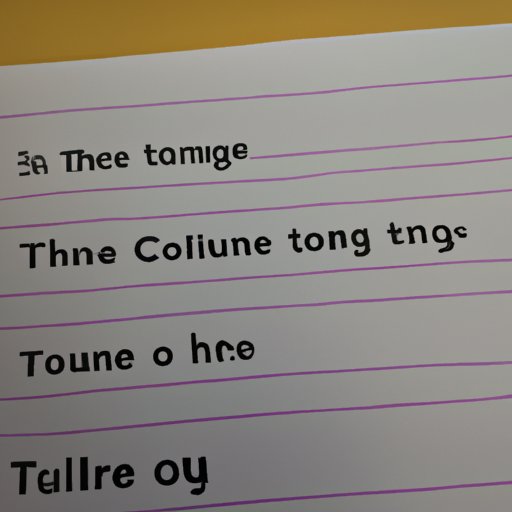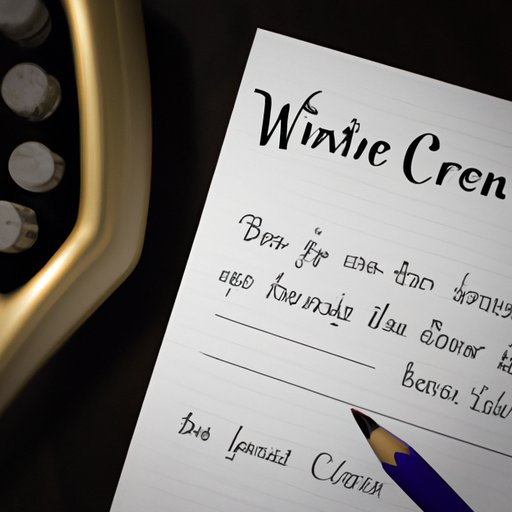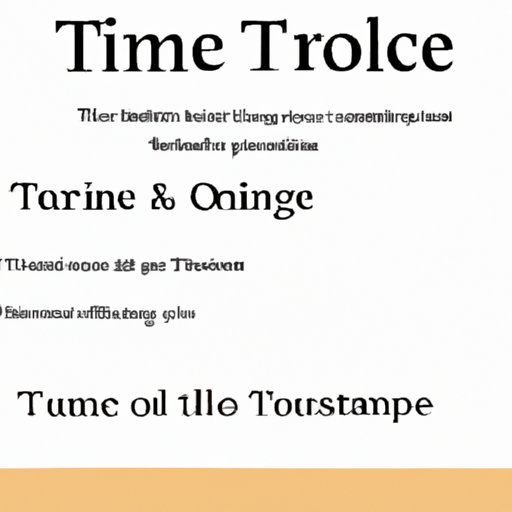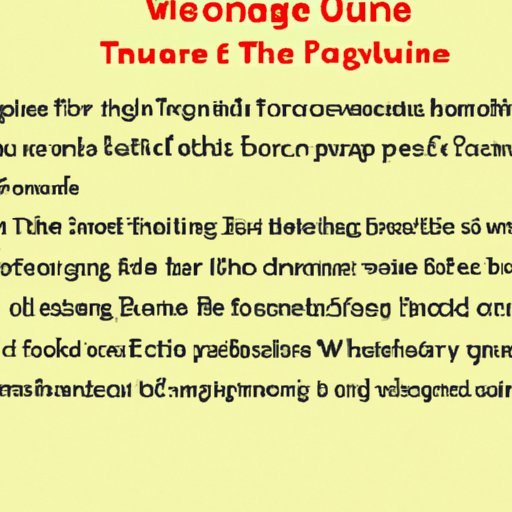Introduction
Tone is an essential element of writing that conveys a writer’s attitude, feelings, and emotions. It is the overall mood or feeling of a piece of writing, and it can be used to create a certain atmosphere or evoke certain reactions from readers. It is important to choose the right tone when crafting any form of writing, as it can either make or break the reader’s experience.
The definition of tone in writing can vary depending on who you ask. Generally speaking, tone is the writer’s attitude towards the subject of the writing. This can be expressed through the words, phrases, and sentences used in the text. Tone can be formal or informal, serious or humorous, depending on the type of writing and the intended audience.

Exploring the Different Types of Tones in Writing
When it comes to writing, there are several different types of tones that can be used. Each type has its own unique characteristics and should be chosen based on the purpose of the writing and the audience it is intended for. Here are some of the most common types of tones in writing:
Formal Tone
A formal tone is typically used in academic writing and business communication. It is characterized by the use of formal language and an objective approach. The goal of a formal tone is to remain professional and avoid any kind of personal opinion or bias. This type of tone is best suited for documents such as reports, essays, and memos.
Informal Tone
An informal tone is more relaxed than a formal tone and uses colloquial language. It is often used in creative writing, such as fiction, blog posts, and social media content. The goal of an informal tone is to engage with the reader and create a connection. This type of tone is best suited for creative pieces that are meant to entertain and inform.
Serious Tone
A serious tone is often used in news articles and other forms of non-fiction writing. It is characterized by the use of facts and an authoritative voice. The goal of a serious tone is to convey information in a straightforward manner and provide the reader with an accurate representation of the topic. This type of tone is best suited for pieces that are meant to educate and inform.
Humorous Tone
A humorous tone is often used in comedy writing, such as stand-up routines, sitcoms, and sketch comedy. It is characterized by the use of jokes and witty remarks. The goal of a humorous tone is to make the reader laugh and enjoy the writing. This type of tone is best suited for pieces that are meant to entertain and lighten the mood.

Crafting the Perfect Tone for Your Writing
Choosing the right tone for your writing is an important step in creating engaging and effective content. Here are some tips on how to craft the perfect tone for your writing:
Identifying the Appropriate Tone
The first step in crafting the perfect tone for your writing is to identify the appropriate tone. Consider the purpose of the writing and the intended audience. Is the writing meant to be informative or entertaining? Is the audience composed of professionals or casual readers? Answering these questions will help you determine the appropriate tone for your writing.
Tailoring the Tone to Your Audience
Once you have identified the appropriate tone for your writing, the next step is to tailor the tone to your audience. Think about what kind of language and topics would appeal to your readers. For example, if your audience is composed of professionals, then a formal tone may be more appropriate. On the other hand, if your audience is composed of casual readers, then an informal tone may be more effective.
How to Identify Different Tones in Writing
Identifying the tone of a piece of writing can be difficult, especially if you are not familiar with the writer’s style. Here are some tips on how to identify different tones in writing:
Analyzing Word Choice
One way to identify the tone of a piece of writing is to analyze the words being used. Look at the words being used and consider the connotations they carry. Are the words formal or informal? Do they evoke strong emotions or are they neutral? Analyzing word choice can help you determine the tone of a piece of writing.
Examining Sentence Structure
Another way to identify the tone of a piece of writing is to examine the sentence structure. Look at the length of the sentences and consider the punctuation being used. Are the sentences long and complex or short and simple? Examining sentence structure can give you insight into the tone of a piece of writing.
Reading Comprehension
Finally, you can identify the tone of a piece of writing by reading it carefully. Pay attention to the overall message and consider how it makes you feel. Does the writing make you feel angry, sad, or happy? Does it make you think? Reading comprehension can help you identify the tone of a piece of writing.
Understanding the Power of Tone in Writing
It is important to understand the power of tone in writing. Tone can be used to communicate a message, set the mood, and create engaging content. Here are some ways that tone can be used to enhance your writing:
Communicating Your Message
Tone can be used to communicate your message more effectively. By choosing the right tone, you can ensure that your message is understood by your readers. You can also use tone to emphasize certain points and make your writing more persuasive.
Setting the Mood
Tone can also be used to set the mood of your writing. Depending on the tone you choose, you can create a sense of excitement, sadness, joy, or fear. Using tone in this way can help you create a more immersive experience for your readers.
Creating Engaging Content
Finally, tone can be used to create engaging content. By choosing the right tone, you can capture the interest of your readers and keep them engaged throughout the entire piece. Tone can also be used to add humor and wit to your writing, making it more enjoyable to read.
Finding the Right Tone for Your Audience
When it comes to finding the right tone for your audience, it is important to consider their needs and preferences. Here are some tips on how to find the right tone for your audience:
Considering Your Target Audience
The first step in finding the right tone for your audience is to consider who they are. Are they professionals or casual readers? Are they experts in the field or beginners? Knowing who your target audience is will help you determine the appropriate tone for your writing.
Utilizing Research to Guide Your Tone
Once you have identified your target audience, the next step is to conduct research to guide your tone. Look for examples of writing that have been successful with similar audiences. Analyze the tone being used in those pieces and use it as a reference for crafting your own writing. Utilizing research in this way can help you find the right tone for your audience.

Using Tone to Enhance Your Writing Style
Using tone to enhance your writing style can make your writing more interesting and engaging. Here are some tips on how to use tone to enhance your writing style:
Establishing a Balance
When using tone to enhance your writing style, it is important to establish a balance. Avoid overusing a certain type of tone and make sure to mix up your writing. This will help keep your readers interested and prevent your writing from becoming monotonous.
Avoiding Monotony
It is also important to avoid monotony when using tone to enhance your writing style. Make sure to use different types of tones throughout your writing and vary your word choice and sentence structure. This will help keep your writing fresh and engaging.
Enhancing the Reader Experience
Finally, using tone to enhance your writing style can help you create a more immersive experience for your readers. By using the right tone, you can evoke certain emotions and create a stronger connection with your readers. This will make your writing more memorable and effective.
Conclusion
In conclusion, tone is an essential element of writing that conveys a writer’s attitude, feelings, and emotions. There are several different types of tones that can be used, including formal, informal, serious, and humorous. When crafting the perfect tone for your writing, it is important to consider the purpose of the writing and the intended audience. Additionally, understanding the power of tone in writing can help you create engaging and effective content. Finally, by utilizing research and avoiding monotony, you can use tone to enhance your writing style and create a more immersive experience for your readers.
(Note: Is this article not meeting your expectations? Do you have knowledge or insights to share? Unlock new opportunities and expand your reach by joining our authors team. Click Registration to join us and share your expertise with our readers.)
